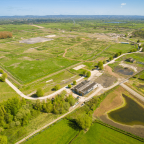
6 Key Construction Trends to Watch in 2023 and 2024
The construction industry is constantly evolving to leverage new technologies, materials, equipment, and processes that improve efficiency, sustainability, and results.
As a contractor or builder, closely tracking emerging construction trends will be imperative to staying market-relevant, competitive, and optimized for success in the coming years. From advanced building materials to digital transformation, a range of pivotal shifts lie ahead in 2023 and 2024.
Here are six major construction trends set to shape the industry over the next two years that construction firms must prepare for today.
1. Mass Timber Adoption
Mass timber refers to large, prefabricated wood elements like cross-laminated timber (CLT), nail laminated timber (NLT) and glued laminated timber. The engineered wood offers strength rivaling concrete and steel with a significantly lighter footprint and faster assembly. As sustainability and speed accelerate, expect mass timber to displace other materials.
Mass timber modular components assemble rapidly on-site, reducing construction schedules 30-50% for many projects. The lighter loads also shrink foundation requirements. The renewable sourcing and carbon sequestration properties align with stricter emissions regulations coming. Fire resistance has proven comparable to non-combustible materials when properly treated.
Watch for updates to building codes expanding timber allowance for taller buildings in more regions. Mass timber will become the go-to material for many structures - familiarity now is crucial.
2. 3D Printing Growth
Known as additive manufacturing in the construction sector, 3D printing is moving beyond concept to practical mainstream adoption for components like walls, roofs, and foundations. As printers and materials science evolve, accelerated 3D printing is imminent.
Benefits like reduced waste, faster assembly, geometric flexibility, and consolidation of elements make 3D printing ideal for complex modules. printers can run 24/7, maximizing automation. The technique allows bespoke architectural creativity. Automation reduces costly labor requirements as well.
Start following innovators in 3D construction like ICON, Mighty Buildings and ApisCor. Look for 3D printing scaling up rapidly over the next few years as more firms start leveraging its advantages. The learning curve now favors early adopters.
3. Robotics and Exoskeletons
Construction remains one of the most labor-intensive industries - and challenging to recruit for currently. Robotics and exoskeletons are now tackling various physically demanding tasks to improve productivity and appeal. Expect exponential advancement in construction robotics ahead.
Robotic arms excel at repetitive assembly like bricklaying with consistency hard for humans to match. Their object permanence also aids creating digital twins using lidar scanning. Walking autonomous machines perform inspections in tricky spots.
Body-worn exoskeletons enhance worker speed, strength, and endurance dramatically when handling heavy materials or tools like jcb excavators - https://www.mascus.com/construction/excavators/jcb. Fatigue sensors customize assistance to the individual user. These technologies will be game changers for many firms.
4. Autonomous Equipment and Vehicles
Today’s construction equipment is evolving to include semi and fully autonomous functionalities for improved safety, productivity, and operational oversight. A new generation of smart machines is close to mainstream emergence.
GPS, lidar, computer vision and other technologies enable everything from grading to paving to operate with minimal manual input, reducing errors and burdensome constant control. Built-in sensors also avoid collisions or tipping when operating autonomously.
On-board telemetry captures expansive equipment performance data to optimize maintenance and identify operator training needs. Autonomous haul trucks and heavy equipment will transform jobsites starting soon. Companies must prepare operations and workers accordingly.
5. Offsite and Modular Construction
Refinements in offsite construction and modular building are making the method increasingly cost-competitive for projects of many types and scale. As productivity, consistency and sustainability benefits become more quantifiable, offsite adoption will accelerate.
Producing components like floor and roof systems under controlled factory conditions allows for higher quality, tighter tolerances, easier customization, and less weather impacts than traditional on-site construction. Just-in-time delivery of finished modules maximizes on-site productivity.
Sophistication of modular buildings makes multifamily, hotels and healthcare facilities ideal starting targets, but endless applications exist. Offsite and modular techniques will shake up traditional construction - make sure your firm takes part.
6. Digital Twins and BIM Advancement
Sophisticated building information modeling (BIM) paired with digital twin simulations will soon yield unprecedented visibility into design considerations, staged construction sequencing, worksite interactions and finishes. BIM and digital twin convergence sits on the horizon.
Next-generation multi-dimensional modeling software integrates seamlessly with 3D/4D digital twins encompassing the complete asset lifecycle. Design decisions, construction means and methods, and operational dynamics can be assessed virtually before execution for unparalleled accuracy and optimization. This fusion will prove transformational.
As BIM tools evolve, virtual prototyping through digital twins becomes pivotal. Joint adoption readies firms for more predictability, less waste and new efficiencies during delivery and beyond. Data integration expertise will be mandatory.
Conclusion
The construction sector is entering an era of unprecedented technological transformation ranging from materials to methods to equipment. These 7 trends represent must-know shifts that will shape the competitive landscape in 2023 and 2024.
From mass timber and 3D printing to robotics and digital twins, embracing change will determine winning firms. Use this overview to guide your organization’s readiness gameplan. Prioritize skills development, technology adoption and culture evolution to smoothly integrate cutting-edge solutions.












